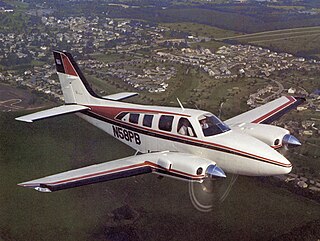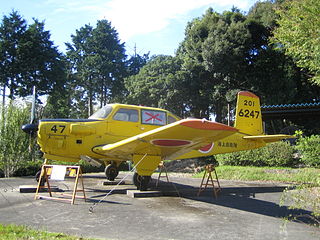
The Piper PA-23, named Apache and later Aztec, is an American four- to six-seat twin-engined light aircraft aimed at the general aviation market. The United States Navy and military forces in other countries also used it in small numbers. Originally designed as the Twin Stinson in the 1950s by the Stinson Aircraft Company, Piper Aircraft manufactured the Apache and a more powerful version, the Aztec, in the United States from the 1950s to the 1980s.

The Beechcraft Bonanza is an American general aviation aircraft introduced in 1947 by Beech Aircraft Corporation of Wichita, Kansas. The six-seater, single-engined aircraft is still produced by Beechcraft and has been in continuous production longer than any other aircraft in history. More than 17,000 Bonanzas of all variants have been built, produced in both distinctive V-tail and conventional tail configurations; early conventional-tail versions were marketed as the Debonair.

The Beechcraft Travel Air is a twin-engine development of the Beechcraft Bonanza. It was designed to fill the gap between the single engine Model 35 Bonanza and the much larger Model 50 Twin Bonanza, and ultimately served as the basis for its replacement, the Baron.

The Beechcraft Baron is a light twin-engined piston aircraft designed and produced by Beechcraft. The aircraft was introduced in 1961. A low-wing monoplane developed from the Travel Air, it remains in production.

The Beechcraft L-23 Seminole was the United States Armed Forces designation for the Beechcraft Twin Bonanza and Queen Air aircraft in its inventory.

The Beechcraft Model 17 Staggerwing is an American biplane with an atypical negative wing stagger. It first flew in 1932.

The Piper PA-34 Seneca is a twin-engined light aircraft, produced in the United States by Piper Aircraft. It has been in non-continuous production since 1971. The Seneca is primarily used for personal and business flying as well as multi-engine class rating flight training.

The Beechcraft Model 76 Duchess is an American twin-engined monoplane built by Beechcraft intended partly as a low cost introduction to twin-engine aircraft.

The Beechcraft Musketeer is a family of single-engined, low-wing, light aircraft that was produced by Beechcraft. The line includes the Model 19 Musketeer Sport, the Model 23 Musketeer, Custom and Sundowner, the Model 23-24 Musketeer Super III, the retractable gear Model 24R Sierra and the military CT-134 Musketeer.

The Beechcraft Model 77 Skipper is a two-seat, fixed tricycle gear general aviation airplane, originally designed for flight training but also used for touring and personal flying.

The Beechcraft Model 99 is a civilian aircraft produced by Beechcraft. It is also known as the Beech 99 Airliner and the Commuter 99. The 99 is a twin-engine, unpressurized, 15 to 17 passenger seat turboprop aircraft, derived from the earlier Beechcraft King Air and Queen Air. It uses the wings of the Queen Air, the engines and nacelles of the King Air, and sub-systems from both, with a specifically designed nose structure.

The Beechcraft Queen Air is a twin-engined light aircraft produced by Beechcraft in numerous versions from 1960 to 1978. Based upon the Twin Bonanza, with which it shared key components such as wings, engines, and tail surfaces, it had a larger fuselage, and served as the basis for the highly successful King Air series of turboprop aircraft. Its primary uses have been as a private aircraft, utility, and small commuter airliner. Production ran for 17 years.

The Bellanca Viking and Super Viking are a series of single-engine, four-seat, high performance, retractable gear aircraft manufactured in the USA during the 1960s and 1970s. The aircraft developed through modifications of classic designs by the aviation pioneer Giuseppe Bellanca. A total of 1,356 Vikings have been produced with most production between 1968 and 1975.

The Beechcraft AT-10 Wichita is an American World War II trainer built for the United States Army Air Forces (USAAF) by Beechcraft. It was used to train pilots for multi-engined aircraft such as bombers.

The Beechcraft CT-134 Musketeer is a military training derivative of the Musketeer built by Beechcraft for the Canadian Armed Forces. The CT-134 was a single engine, low-wing, four-seat light aircraft with fixed landing gear and a limited aerobatic capability.

The Piaggio P.166 is an Italian twin-engine pusher-type utility aircraft developed by Piaggio Aero. The aircraft model name was Portofino, and is also known as Albatross in South African military service.

The Fuji KM-2 is a Japanese propeller-driven light aircraft, which was developed by Fuji Heavy Industries from the Beechcraft T-34 Mentor which Fuji built under licence. Various versions have been used as primary trainers by the Japan Self-Defense Forces.

The Beechcraft Model 34 "Twin-Quad" was a prototype airliner designed and built by Beechcraft in the period between World War II and the Korean War. At this time many aircraft manufacturers in the United States anticipated a boom in civil aviation and a large number of designs left the drawing board only to ultimately fail. The Model 34 was one of these failures, partly because of its unusual design, and partly because of the thousands of ex-military transport aircraft that were available at the time for a fraction of the price of a new aircraft.

The Piper Aerostar is an American twin-engined propeller-driven executive or light transport aircraft, designed by Ted R. Smith. It was originally built by Ted Smith Aircraft Company, but the design was acquired in 1978 by the Piper Aircraft Corporation, which continued production of the aircraft as the PA-60.

The Lycoming GO-480 is a family of six-cylinder, horizontally opposed fixed-wing aircraft engines of 479.6 cubic inch displacement, made by Lycoming Engines. The engine is a six-cylinder version of the four-cylinder Lycoming O-320.
























